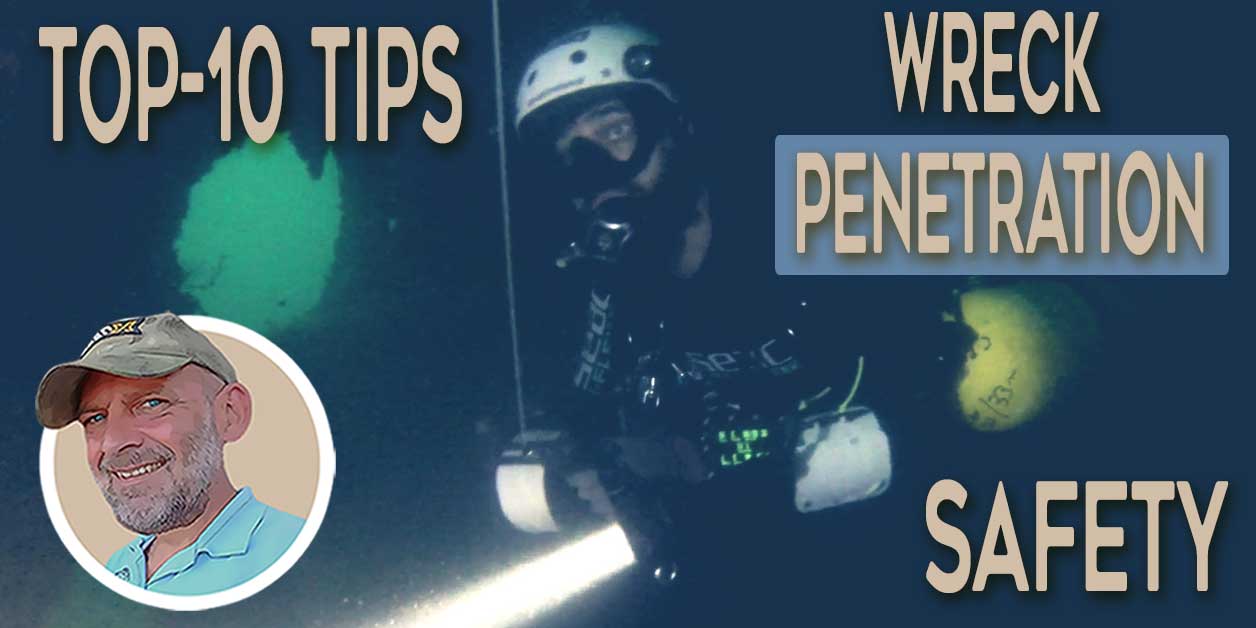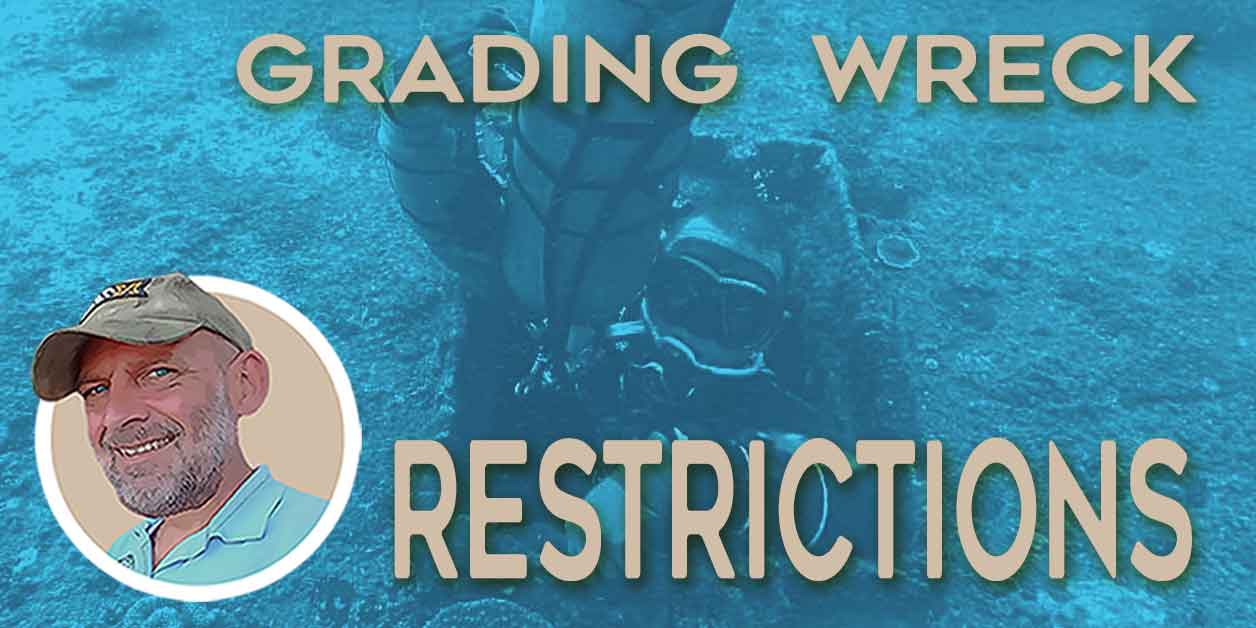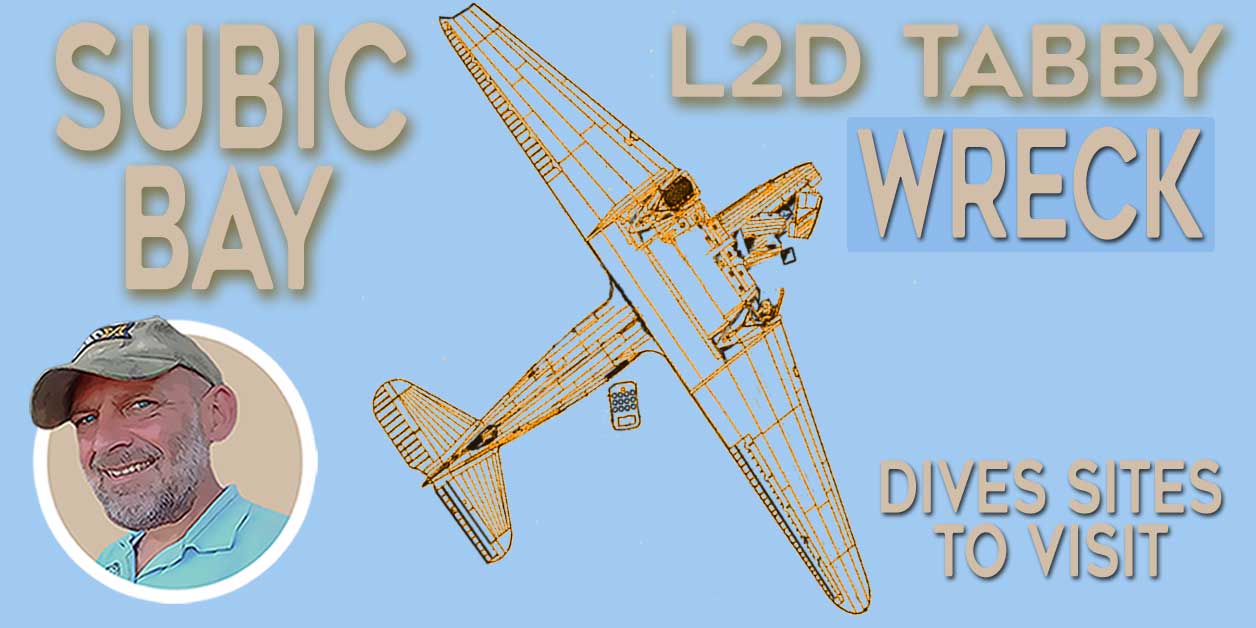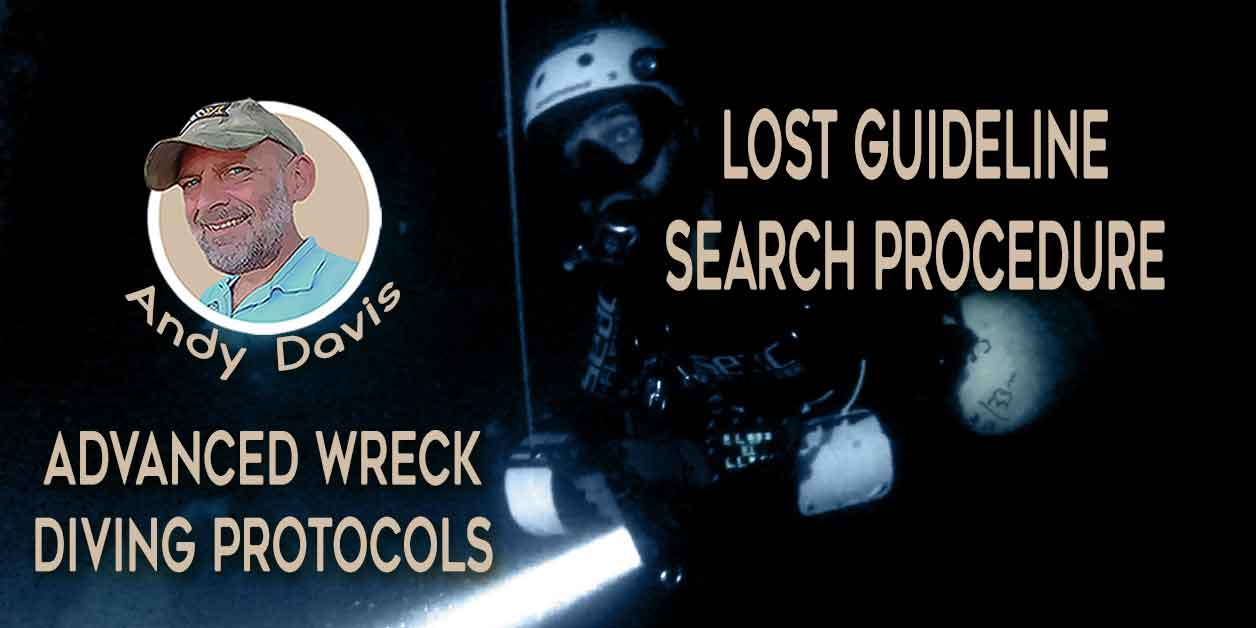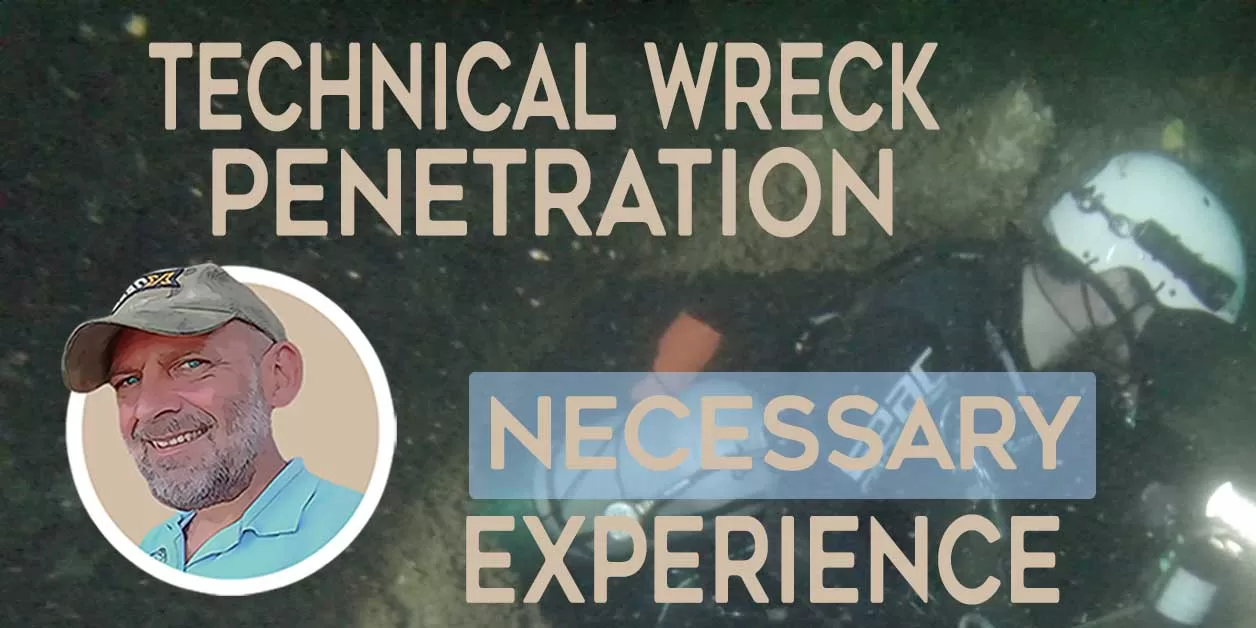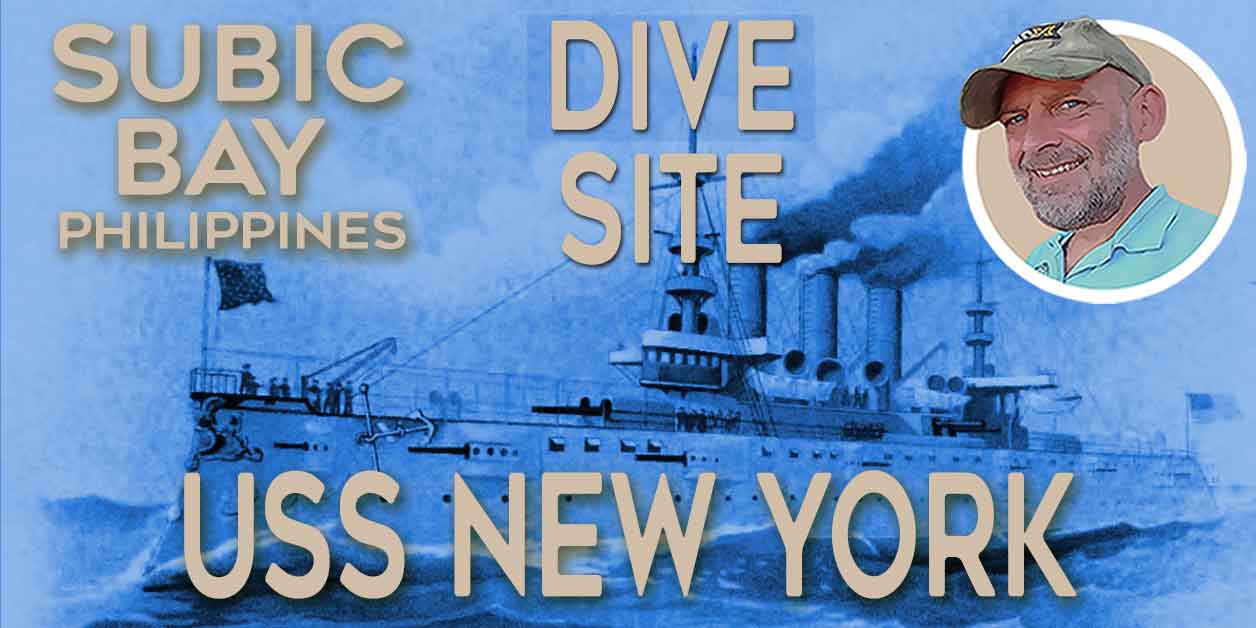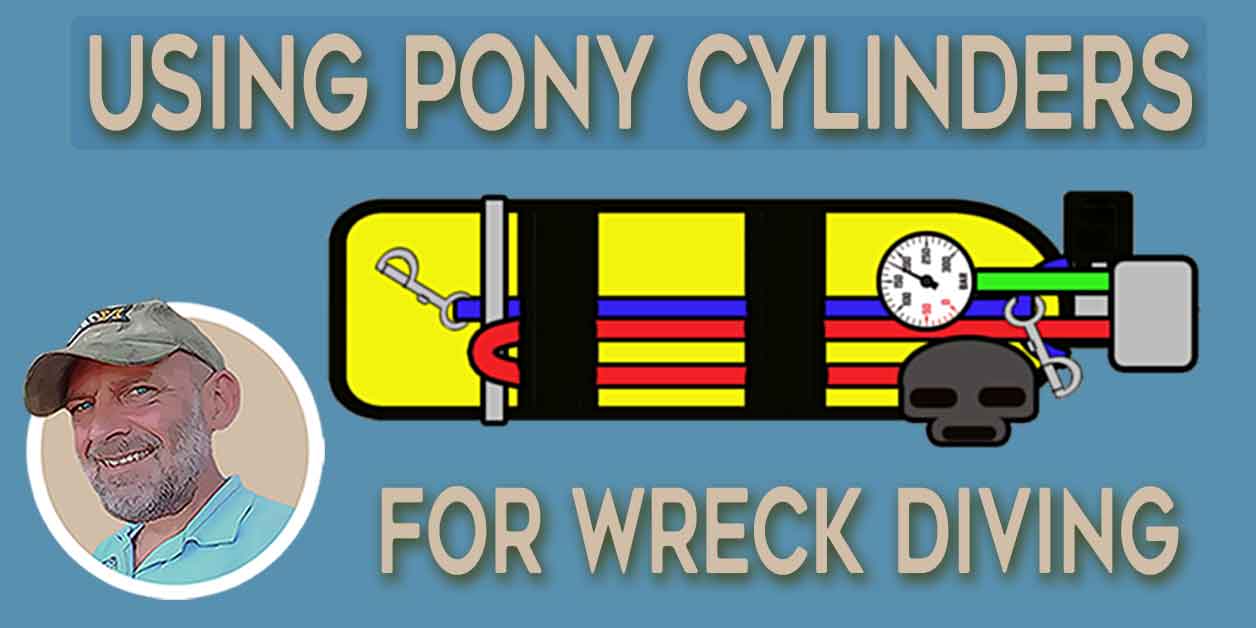The Most Iconic Technical Wrecks: A Bucket List for Tech Divers
As a scuba diver, you probably know that exploring a sunken vessel is a thrilling and unique experience. Amongst the most passionate wreck aficionados are the tech divers that seek out the deepest, most dangerous technical wrecks. Among the many technical wrecks around the world, some stand out as bucket list challenges; the most iconic wrecks are those steeped in history, mystery, and tragedy. These can be amongst the most extreme diving destinations for underwater exploration in the world!
In this article, I will describe some of the most iconic technical wrecks that hardcore tech divers dream of visiting. From the HMS Victoria, lost with all hands in 1893, to the HMHS Britannic, sister of the Titanic, we will explore the depths of the ocean to discover the fascinating stories of these wrecks. Keep reading to uncover the mysteries of the USS Saratoga, SMS Markgraf, the Gunilda, the Andrea Doria, the San Francisco Maru, the SS Maidan, the RMS Lusitania, the RMS Carpathia, and of course, the legendary HMS Victory (1737).
What defines an iconic technical wreck dive?
An iconic technical wreck dive is one that is renowned among technical divers for a combination of factors that include size, depth, historical significance, and inaccessibility. Technical divers seek out such technical wrecks for the unique challenges and experiences they offer, as well as the opportunity to connect with history and explore the depths of the ocean.
The size of the wreck is a critical factor in determining its iconic status. Large vessels, such as battleships, ocean liners, and aircraft carriers, are often the most sought-after by technical divers. These wrecks offer a sense of grandeur and scale that smaller wrecks cannot match.
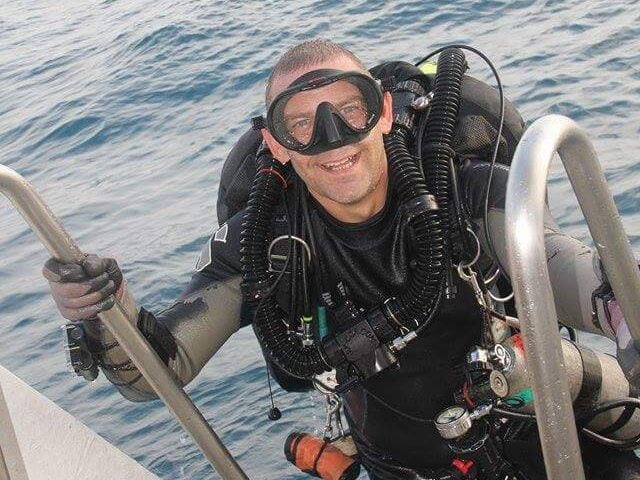
Depth is another important factor that contributes to the iconic status of a technical wreck dive. It is not uncommon for technical divers to qualify at full trimix level and buy a CCR, but the deepest of technical wrecks can lay far below the levels that most seasoned tech divers are comfortable with.
The historical significance of a wreck is another critical factor in the iconic status of technical wrecks. Tech divers are often drawn to wrecks with rich historical backgrounds, such as warships or vessels with significant cultural or archaeological importance. Exploring such wrecks provides a unique opportunity to gain insight into past events and cultures.
Finally, inaccessibility is another factor that contributes to the iconic status of technical wrecks. Wrecks that lie in remote locations, are difficult to access, or are subject to extreme weather conditions, are often the most sought after by technical divers because few others will have dived them.
What is considered a deep technical wreck dive?
The definition of what constitutes a deep technical wreck dive has evolved over the years. Back in the 90s, diving to depths between 60 to 80 meters was nothing short of nerve-wracking, and something that only a select few daring technical wreck divers could undertake.
Fast forward to today, and the modern pioneers of technical wreck diving are descending to wrecks at depths of 240m to 320m. The advent of cutting-edge CCR technology, mixed-gas diving, and rigorous specialized training regimens have made it possible for these intrepid divers to explore deeper, more treacherous waters in their quest to dive the most iconic and meaningful deep-water technical wrecks.
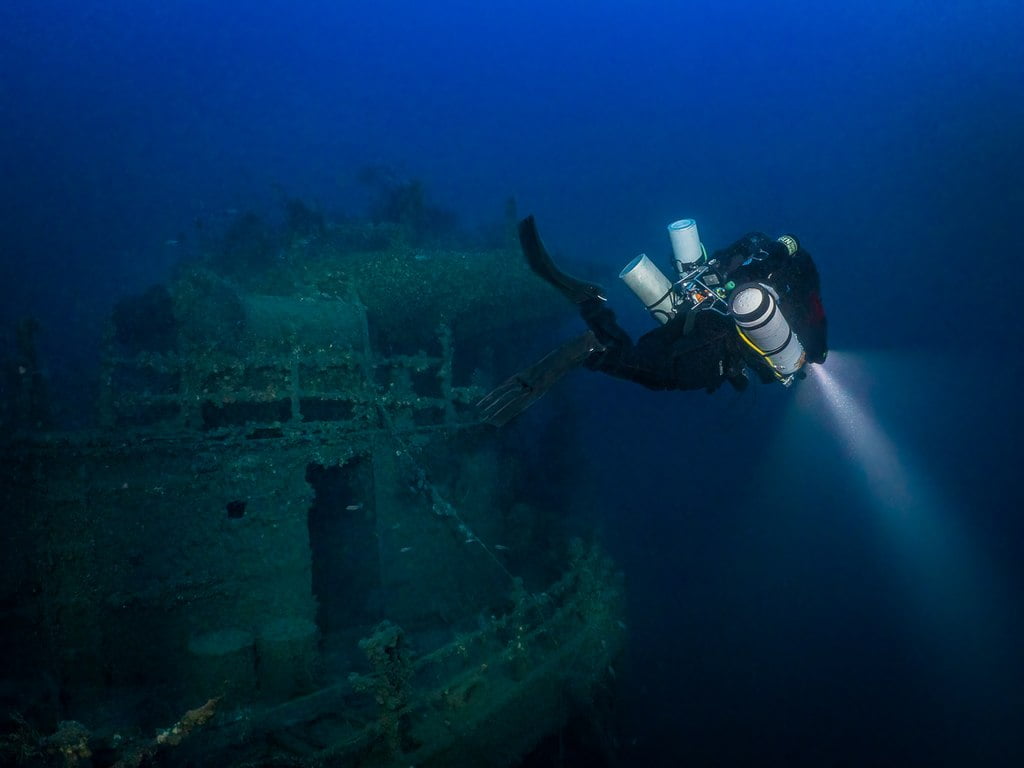
What are the most iconic technical wrecks?
There will always be disputes when subjective decisions are made, and I’m sure some technical wreck divers would have their own bucket list wrecks to include on aspirational diving shortlists. The top-12 most iconic technical wrecks to dive are:
- HMHS Britannic (121m/400ft) Kea Island, Greece
- SMS Markgraf (45m/147ft) Scapa Flow, Scotland
- The Gunilda (80m/262ft) Rossport, Canada
- The Andrea Doria (76m/236ft) Massachusetts, USA
- San Francisco Maru (64m/210ft) Chuuk Lagoon, Micronesia
- HMS Hermes (53m/174ft) Batticaloa, Sri Lanka
- SS Maidan (120m/394ft) Marsa Alam, Egypt
- RMS Lusitania (91m/300ft) 18 km off Kinsale, Ireland
- HMS Victoria (150m/493ft) Tripoli, Lebanon
- RMS Carpathia (152m/500ft) 120 km off Fastnet, Ireland
- HMS Victory (78m/256ft) 84 km off Plymouth, England
- USS Saratoga (50m/167ft) Bikini Atoll, Marshall Islands
Share your experiences about favorite technical wrecks you have dived, or aspire to visit, in the comments section at the bottom of this article!
I. HMHS Britannic
HMHS Britannic, the sister ship of the infamous RMS Titanic, is considered one of the most iconic and sought-after technical wrecks in the world. Discovered by French oceanographer Jacques-Yves Cousteau in 1975, this nearly fully intact wreck lies at a depth of about 121m (400ft) off the coast of the Greek island of Kea in the Aegean Sea. However, diving the 883 feet long Britannic is not for the faint-hearted. Only a handful of expert technical divers have explored this wreck due to its extreme depth, limited access, and challenging diving conditions.
The Britannic sank in 1916, during World War I, after hitting a naval mine of the Imperial German Navy. Unlike the Titanic, which rests at a depth of over 12,000 feet, the Britannic is within reach of expert technical divers, but its depth and occasionally fierce currents still pose significant challenges. In 2009, the Britannic claimed its first victim when Carl Spencer lost his life during a dive on the wreck. The ship lies on her starboard side, with an inclination of about 85 degrees, and the three propellers and the rudder are still in place.
Access to the Britannic used to be strictly controlled and permission was granted only once a year to qualified organizations. However, since 2017 the process became easier for organized dive projects to gain access, with 3-5 expeditions being approved per year. In 2023, the Greek government designated the area as a marine park and the permit system was scrapped. The wreck can now be dived without any bureaucratic issues, simply utilize a recognized and reputable diving operation, such as Kea Divers, to support your trip there.
Diving the Britannic is a dream come true for many technical wreck divers due to its historical significance, difficulty in accessing, and the challenge it presents. Mark Powell, a technical diving expert who visited the Britannic, called it one of his bucket-list wrecks, noting its incredible history, the difficulty of diving it, and the scale of the wreck itself. Overall, the HMHS Britannic wreck offers a thrilling and unforgettable diving experience to those who have the skill, experience, and opportunity to explore it.
II. SMS Markgraf
SMS Markgraf was a König class battleship built for the Imperial German Navy and served during World War I. This impressive wreck, at a depth of 45m (147ft) and measuring 175 meters long, is considered the crown jewel of Scapa Flow. The ship was scuttled in 1919 along with 73 other German vessels to prevent them from falling into British hands. Despite significant salvage efforts between 1920 and 1945, only seven ships remain, including the SMS Markgraf. Today, these massive battleships, along with British naval vessels and block ships, create a remarkable tec diving wonderland.
The SMS Markgraf lies inverted and mostly upturned on her starboard side, with the superstructure preventing her from rolling over entirely. Her impressive size is evident thanks to her many features remaining largely intact, including the bow, stern, and rudders. She is particularly noteworthy for her pristine condition, demonstrating the sheer scale of the German battleships.
The Markgraf was the third of four König class battleships, weighing 25,388 tons, with a length of 175 meters, 30 meters at the beam, and a draft of 9 meters. She was powered by three turbines developing 46,000 hp (34 MW) each, yielding a maximum speed of 22 knots. Her armament consisted of ten 305 mm guns, fourteen 150 mm guns, six 85 mm guns, and five 500 mm torpedo tubes. She carried a crew of 1136 men and officers.
Built at the AG Weser shipyard in Bremen, the Markgraf served in the Third Battle Squadron and participated in the Battle of Jütland on 31 May 1916. Her final fight occurred in Scapa Flow, where she was scuttled. The captain, Walter Schumann, and chief officer Hermann Dittman were killed by Royal Marines attempting to prevent the scuttling. On 21 June 1919, the SMS Markgraf vanished beneath the surface.
The Markgraf has received less salvage activity compared to the other two battleships, making it the more intact and, perhaps, most interesting for divers. However, her five main turrets are mostly buried, with only parts of turrets A&B visible.
The central section of the wreck on the starboard side is the area of interest for divers, extending from 26 meters and cascading down to the seabed. The control tower, foremast, and spotting top lying on the seabed perpendicular to the side of the ship are the main attractions. However, caution should be taken, as this area is a jumble of metal.
Despite showing signs of its 100+ years underwater and salvage efforts, the Markgraf still retains its size and mass, making it a world-class dive site. It takes 2-3 dives to get a clearer understanding of the layout, but the effort is worth it. The best time to visit Scapa Flow and dive the SMS Markgraf is between April and October.
III. The Gunilda
The Gunilda is a historic shipwreck located in Lake Superior, near Rossport, Ontario, Canada. This magnificent vessel was built in 1897 and was considered one of the most luxurious private ships of her time. Unfortunately, she met her fate in 1911 when she ran aground on McGarvey Shoal, causing her to sink to a depth of 80 meters (262ft).
Despite being submerged for over a century, the Gunilda remains in an excellent state of preservation due to the cold, freshwater conditions of Lake Superior. In fact, it is often referred to as one of the best-preserved wrecks in the world. Many technical divers consider it the pinnacle of their diving career, and it is not hard to see why.
The Gunilda sits upright on the lake floor at a depth of approximately 85 meters (280 feet), with everything aboard still intact. This includes the gold-covered bowsprit, the ship’s compass in the binnacle, and even the grand piano in the salon. Personal items and furniture are still visible, providing a glimpse into the ship’s luxurious past.
Diving the Gunilda is a technical dive that requires trimix and meticulous planning. The best time to visit the wreck is from June to September when the weather conditions are favorable. There are dive operators with experience running trips to the Gunilda.
Overall, the Gunilda is a fascinating piece of maritime history that has been preserved in a near-perfect condition. It serves as a reminder of the dangers that can befall even the most luxurious
IV. The Andrea Doria
The Andrea Doria, an Italian luxury liner of the post-World War II era, has become infamous in the diving community for its challenging conditions. Colliding with another passenger liner in 1956, the ship came to rest on its starboard side in 72m (250ft) of water. Although 1,660 passengers and crew were rescued, the ship met its demise, making the Andrea Doria one of the most epic maritime disasters ever.
Diving the Andrea Doria is known to be a physically challenging task due to the highly variable conditions. Visibility can range from 100 feet (30 meters) to a mere 10 feet (3 meters), while currents can change in the blink of an eye. Although penetration is possible, the ship’s rapid deterioration makes this a significant risk. However, the willingness of divers to explore this wreck since the 1950s has pushed technological advances in tec diving equipment and furthered the sport without measure.
Originally, nicknamed the “Mount Everest of diving” in reference to the wreck’s depth, current, and cold waters, it has long since been superseded by deeper, more demanding wrecks at the pinnacle of exploration diving. The heyday of Doria diving began in the 1980s, with improved gear making it possible for divers to stay on the wreck longer and penetrate the wreck’s interior.
The Andrea Doria has largely disintegrated, a far cry from its golden era 4 decades ago. Despite the hull’s significant deterioration, the Andrea Doria continues to captivate hardcore divers worldwide. The dive once defined deep ocean wreck diving and inspired developments in technical diving, so that it could be explored safely.
Diving the Andrea Doria is still a physical challenge, but technological advancements have made it safer than ever before. Mixed gas diving on either open-circuit scuba or rebreathers is now the norm. While there may be deeper and more historic wrecks worldwide, the Andrea Doria remains the epitome of challenging wreck diving and a dive that any self-respecting technical wreck diver would love in their log book.
V. San Francisco Maru
The San Francisco Maru is many technical wreck diver’s dream destination located in Chuuk Lagoon, Micronesia. This passenger ship sank during World War II and sits at a depth of 64m (210 ft) with its deck located at 49m (160ft). This depth requires tec diving to explore this incredible wreck.
Divers are reminded to treat the San Francisco Maru with respect, not only for its depth but also for the fact that it is a war grave and still contains bodies. Despite this somber reminder, the wreck remains a favorite among the technical diving community for its four cargo holds, which contain a treasure trove of wartime artifacts. The first hold is filled with aircraft bombs, artillery shells, mines, and cable spools. The second hold houses two tanker trucks and a flatbed truck, while the third deck contains another truck. Finally, the fourth deck contains torpedo warheads, depth charges, mines, ammunition, and the remains of casualties.
Due to its abundance of expensive cargo, including tanks, trucks, mines, ammunition, aircraft bombs, torpedoes, and depth charges, the San Francisco Maru is known as the “Million Dollar Wreck.” The freighter was commissioned into the Japanese Imperial Navy during WWII and was used to transport war materials between Japan and its Pacific Island territories and occupied islands.
Despite its depth, the San Francisco Maru has become a popular diving destination for those looking to explore its fascinating history and unique sights. The wreck boasts two Japanese Type-95 light tanks, a 75mm (3-inch) bow gun, and a large steamroller resting in the sand at 62m (205ft). Also on the ship’s main deck, next to the two tanks on the starboard deck, is a 1.5-ton 4×2 Isuzu Type 94 flatbed truck. Above the second cargo hold, two partially collapsed trucks rest on the upper decks. Below them, fuel drums, ammunition, and aircraft bombs can be seen.
In summary, the San Francisco Maru is a technical wreck diver’s paradise, offering the opportunity to explore wartime artifacts in a somber but fascinating setting. Its depth and relative ease to visit make it a favorite among the technical diving community.
VI. HMS Hermes
The HMS Hermes is a unique and historic shipwreck located off the east coast of Sri Lanka. She was the first purpose-built aircraft carrier in the world and had a distinguished career in the Far East. However, she was sunk in April 1942 by the Japanese in one of the most accurate bombings of a ship ever seen. The attack was carried out by over 80 Japanese Zero fighter bombers, catching the Hermes without fighter cover. Despite firing every gun, the ship was helpless against such an onslaught and sank in less than an hour, resulting in the loss of the Captain, 19 officers, and 288 ratings on board.
The HMS Hermes is one of the very few aircraft carriers that can be dived, making her an incredibly unusual wreck. She is lying on her port side at a bottom depth of 53m (174 ft), and the control tower and several other key areas of the wreck are still clearly visible, including intact glass, bulbs in the emergency lights, gauges, bow guns still aiming skyward, and anchors.
HMS Hermes was discovered by a local diver, Felician Fernando, about 60 years after she sank, but was infrequently dived due to her location in an area of civil war. Only when Sri Lanka’s civil war subsided in 2009 was the aircraft carrier re-opened to technical wreck divers.
To date, the wartime wreck remains relatively unexplored. The access point for the wreck is the eastern Sri Lankan town of Batticaloa, which is about a 6-7 hour drive across the country from the international airport in Colombo. The logistics for travel and diving for HMS Hermes aren’t too difficult, with knowledgeable dive operations in the area. Diving the Hermes is very possible for a group of keen technical wreck divers.
Aggressor Liveaboard Sri Lanka
VII. SS Maidan
The SS Maidan is a historical wreck located off the south side of Rocky Island in Marsa Alam, Egypt. The SS Maidan was built in Glasgow, Scotland in 1912 for T & J Brocklebank of Liverpool and London. This “Steel Screw” Steam Cargo Ship had a length overall of 500 feet and a depth of 230m (394 ft). This 1912 troop transport steamer was requisitioned by the Ministry of War Transport during World War I and carried the Liverpool Scottish Regiment and the Queen’s Westminster Rifles infantry battalions to France in November 1914. Although the Maidan was not on the dive map until 2003, it has since become an aspirational wreck dive for technical wreck divers.
In 2003, the wreck was discovered by Grant Searancke and Kimmo Hagman, and it has since become a popular dive site for technical wreck divers. Despite its historical significance, the Maidan remains largely unexplored and offers a unique opportunity for adventurous technical wreck divers to explore a piece of World War I history. Today, the wreck is found at depths of between 80 and 120 meters, making it a challenging dive for even the most experienced technical wreck divers.
Despite its relative obscurity, the Maidan wreck offers an impressive sight. The clear waters of the Red Sea make it easy to inspect the wire coral-covered bow and explore the inside of the hull. The wreck is nearly complete and is relatively undisturbed, as only a few technical wreck divers visit the site each year. This makes the Maidan one of the least-documented wrecks in Egypt.
VIII. RMS Lusitania
The RMS Lusitania was a 38,000-tonne trans-Atlantic voyager that was torpedoed by the German U-boat U-20 in May 1915. She sank in just 18 minutes, making it one of Britain’s most devastating marine tragedies as 1,198 men, women, and children perished in the frigid seas 18 km off the coast of western Ireland. The wreck of the Lusitania remains a poignant reminder of the events that unfolded.
Today, the Lusitania lies on her starboard side in 91m (300 ft) of water, rapidly deteriorating due to corrosion combined with the potency of tides and currents in the Celtic Sea. Due to the poor condition of the superstructure, there have been recent attempts to list the wreck as a World Heritage Site. Diving the wreck requires permission, and a license must be sought.
For technical wreck divers, the opportunity to explore the Lusitania is becoming increasingly limited due to the ship’s rapid decay. The shallowest point of the wreck, which was once only 70 meters (260 feet) below the surface, now lies well past the 90 meters (300 feet) mark, and the superstructure is decaying at alarming rates. As a result, many divers have run into troubles while diving; deep sections, strong currents, and low visibility create a precarious experience. Diving at slack tide is crucial. Additionally, Ireland holds tight access to the permits needed to dive the Lusitania, so achieving this dive would require a committed team who were willing to do a lot of preparation and planning in advance.
IX. HMS Victoria
HMS Victoria, located off the coast of Tripoli, Lebanon, is a unique shipwreck that stands in a vertical position, with a quarter of its length buried in the sea floor at 150m (493 ft), while its stern at 76m (250 ft) offers two enormous propellers and rudder. It is considered to be the only known shipwreck in the world in a 90-degree position. The ship was launched in 1887 and represented the end of decades of inconsistency in warship design. It was the flagship of Admiral Tryon of the Royal Navy’s Mediterranean Fleet and sank from a collision with HMS Camperdown in about 10 minutes. More than 350 of the ship’s company, including Admiral Tryon, perished with the ship.
The wreck was discovered in 2004 by Christian Francis, a Lebanese-Austrian diver who had been searching for the wreck for a decade, with the assistance of Mark Ellyatt. Despite its size, HMS Victoria presented a very small indication on the echo sounder, making it a challenging wreck to locate. The dive depth ranges between 95 and 110 meters, and the visibility can reach up to 50 meters.
The ship’s massive aft 9.2-ton turret is still in place, and the wreck is a fascinating sight for experienced technical wreck divers. However, diving at this depth requires proper training, equipment, and safety measures due to the risk of decompression sickness and other hazards. Technical wreck divers should be cautious while exploring the site and follow all necessary safety protocols. Nonetheless, the historical significance of HMS Victoria and its unique position make it an exceptional site for experienced wreck divers seeking a challenging and rewarding dive.
X. RMS Carpathia
For any avid technical wreck diver, exploring the wreckage of the RMS Carpathia would be an exciting challenge. This Cunard Line passenger steamship was built by Swan Hunter & Wigham Richardson in their shipyard in Wallsend, England, and it is best known for rescuing survivors from the sinking of the Titanic in 1912. However, the Carpathia’s own tragic end came in 1918 when it was torpedoed and sunk by a German U-boat off the southern coast of Ireland. The ship was struck by three torpedoes and sank, with five crew members losing their lives.
The wreckage of the Carpathia remained undiscovered for many years until 1999 when it was located intact and lying upright at a depth of more than 152m (500 ft). American novelist Clive Cussler founded the National Underwater and Marine Agency (NUMA) in 1979, and the Carpathia became a natural target for the organization. In 1999, a search team was put together in conjunction with a new television series, The Sea Hunters, which included Cussler himself, archaeologist James Delgado, and commercial diver Mike Fletcher.
The search for the Carpathia was not without its challenges, as the lack of an accurate starting location meant that a systematic survey had to be undertaken using side-scan sonar and a magnetometer. Despite the rich hunting ground for U-boats in the area, the wreck was finally located in May 2000 and positively identified by ROV footage.
In August 2001, a team of British technical divers, Rich Stevenson, Ric Waring, Zaid Al-obaidi, and Bruce Dunton, dived to the wreck of the Carpathia, setting a record for the deepest ever UK wreck dive at the time. The group traveled aboard the Loyal Watcher and recovered a china plate with the Cunard crest, proving conclusively the wreck’s identity as Carpathia.
A second expedition with a 10-strong dive team led by Ric Waring reached the wreck in 2007. The circumstances and details of Carpathia’s sad ending were typical of the many thousands of merchant vessels sunk by enemy action in the First World War. The Carpathia’s significant role in the Titanic disaster ensures that this modest Cunard vessel will never be forgotten.
Video: RMS Carpathia Wreck Diving Expedition 2007
XI. HMS Victory (1737)
As a technical wreck diver, exploring the sunken wreckage of very old historical ships is especially precious because so few centuries-old vessels remain. The HMS Victory (1737) is one such ship, with a tragic history and an intriguing discovery story.
Not to be confused with other subsequent and later vessels named ‘Victory’, this wreck was built in Portsmouth in 1737. The HMS Victory was a Royal Navy 1st Rate Ship of the Line, weighing 1921 tonnes and armed with 28 Royal-crested bronze cannons. On her return from Spain in 1744, the ship encountered a fierce storm in the English Channel and tragically sunk, taking with her the entire crew of 1,150 lives. This remains the greatest single naval disaster ever sustained by Britain in the English Channel.
For centuries, the ship’s location remained a mystery until the salvage company Odyssey Marine Exploration discovered the wreckage in May 2008. The ship was located 45 nautical miles south of Plymouth, UK, at a depth of 78m (256 ft).
The discovery of the HMS Victory was a significant moment in maritime history and a remarkable find for technical wreck divers. However, exploring the wreckage of this ship was no easy feat. Only a relatively small number of days per year provide suitable conditions for diving this far out and in an enormously busy shipping lane.
The HMS Victory was the last Royal Navy ship armed with crested bronze cannons, which are still clearly visible on the wreck. Subsequent warships used iron cannons. In September 2020, a team of experienced divers, led by Dominic Robinson, the officer in charge of the Joint Service Sub Aqua Centre at the Royal Navy Devonport base, completed a challenging dive on the HMS Victory. The team spent over three hours in the water and brought back incredible photographs of her well-preserved cannons and other artifacts.
As a technical wreck diver, exploring the wreckage of the HMS Victory would be a unique opportunity to witness an important piece of maritime history. There simply isn’t another wreck in the world to match its incredible history and the fascinating artifacts still to be seen upon it.
XII. USS Saratoga
The USS Saratoga (CV-3) is a historical aircraft carrier that boasts a fascinating past. She can be found among the many impressive wrecks in Bikini Atoll, Marshall Islands. Commissioned in 1927 as a Lexington-class aircraft carrier, she was initially designed as a battlecruiser before being converted to comply with the Washington Naval Treaty of 1922. Measuring 268 meters (880 ft) in length and weighing 39,000 tons, the USS Saratoga served in World War II, patrolling in the vicinity of Midway Atoll and participating in countless battles, including responding to the attack on Pearl Harbor, the Guadalcanal Campaign, the Battle of Iwo Jima, and various assaults along the Japanese coast.
Despite facing repeated heavy attacks, including sustaining damage from being torpedoed and dive-bombed. Despite the Japanese claiming to have sunk the Saratoga on several occasions, the USS Saratoga survived the war and earned seven US Navy Battle Stars for her exceptional service.
In July 1946, the USS Saratoga was part of Operation Crossroads and Operation Baker, where the US tested the effects of atomic weapons on a navy fleet. While the Saratoga survived the first nuclear blast, she was not as fortunate during the second blast and rapidly sank after being hit by tsunami-like waves. Today, the USS Saratoga rests 50m (167ft) below the water in Bikini’s lagoon.
Exploring the interior of the Saratoga is a remarkable experience for technical wreck divers. Although the ship is vast, only a small fraction of it has been properly explored by technical wreck divers since its sinking; primarily due to the majority of watertight doors being sealed when she sank. The wreck still contains lots of munitions, including bombs, torpedoes, rockets, large caliber gun cartridges, and depth charges.
Technical divers must exercise extreme caution when venturing inside the USS Saratoga, as heavy silt is present throughout the wreck. Excellent buoyancy, trim and propulsion skills are required to avoid silt outs. The USS Saratoga’s interior is a maze of passageways that lead off in all directions to storerooms, workshops, galleys, pantries, mess decks, accommodation decks, and bathrooms.
One of the most impressive areas to visit on the USS Saratoga is the Command Information Center (CIC); the nerve center of the ship during wartime operations. Technical divers can also explore the cabins used by senior naval officers, the ready room where pilots were briefed on their upcoming missions, and the machine shops filled with lathes, drills, and other tools.
Perhaps the most often remarked about area inside the USS Saratoga is the dentist’s surgery and sick bay. Technical divers can observe three dentist chairs, complete with dental drills, instruments, and rinse bowls. Everything is almost perfectly preserved, and the room would look like it was just waiting to receive its next patient if it weren’t for the fine layer of silt covering everything.
Whilst far from the most extreme depth wreck on this bucket list, the USS Saratoga has a remarkable history and is incredibly large. It is a fascinating wreck for technical wreck divers to penetrate and explore. There are a number of reputable technical diving liveaboards offering expeditions to dive the USS Saratoga; I recommend The Dirty Dozen expeditions or Lust4Rust to arrange trips to Bikini Atoll.
The Bucket List of Iconic Technical Wrecks
In conclusion, technical diving enthusiasts have a deep passion for exploring the world’s most challenging and iconic wrecks. These technical wrecks offer a unique glimpse into history, mystery, and tragedy that can only be experienced by those determined enough to venture into the deepest depth or the most remote or inaccessible locations.
From the tragic loss of the HMS Victoria to the largest dived shipwreck in the world, the HMHS Britannic, these wrecks are bucket list challenges for tech divers. I have explored some of the most fascinating wrecks in the world, including the SMS Markgraf, the Gunilda, USS Saratoga, the Andrea Doria, the San Francisco Maru, the SS Maidan, the RMS Lusitania, the RMS Carpathia, and the legendary HMS Victory (1737). As a technical diver, visiting these wrecks can be a life-changing experience; no matter how complex or demanding the project is.
How can I dive technical wrecks?
I have been training technical wreck divers for several decades and understand the developmental process that is necessary to progress to this pinnacle level of diving ability. If you have the ambition to dive the technical wrecks mentioned in this article it is necessary to gain the right training, equipment, skills, knowledge, experience, and mindset to dive them safely.
Choose the right technical diving gear configuration
It is best to consider your long-term goals and develop yourself with a “beginning with the end in mind” philosophy. Long-term planning helps you make important decisions at the outset; such as which equipment configuration you should choose; CCR, open-circuit backmount, or sidemount. CCR is the obvious choice for extreme depths, whereas sidemount is better if your goals are to penetrate within confined wreck environments. Seek training in the equipment from a reputable subject matter expert specialist instructor.
Get technical diving certification
Having certified on the equipment you will subsequently use, the next steps are to prepare yourself effectively, decide which technical training agency is best for you, and enroll in a reputable technical diving course. I recommend progressing until at least extended-range certification before seeking technical or advanced wreck training. However, you may wish to progress all the way to full trimix certification before switching your focus to wreck diving.
Get an advanced or technical wreck certification
Finding the best technical wreck course isn’t easy. Only a small handful of very specialist instructors offer this training at a high level of competency. You will probably have to travel to a location where access to suitable training wrecks exists. Reputable technical wreck instructors don’t compromise their courses by diving at wreck sites without extensive penetration routes, or at depths that preclude long training dives.
Before enrolling in an advanced or technical wreck course, you should ensure that you have already gained a very high proficiency and familiarity with technical diving equipment, skills, and protocols. High-level wreck diving courses are enormously challenging and success is unlikely if you have deficiencies in prerequisite advanced diving competencies.
Acquire and progress your tech experience conservatively
Once appropriately certified in technical and wreck diving, you should aim to progressively extend your experience by conducting increasingly deep and sophisticated dives. The critical attribute in doing this safely and effectively is patience. Frequent factors in technical wreck diving fatalities are the incautious speed of diving progression, complacency, and false confidence through overestimating one’s ability to conduct dives.
Conduct dozens of dives and log hundreds of diving hours experience before making any substantial increases in the complexity and risk of the dives you undertake. Actively seek out constructive criticism and proficiency appraisal from unbiased mentors and peers in the technical wreck community. Remain wary of instructors who might inflate your self-estimation of ability as a means to sell you more courses.
Avoid the pitfalls of becoming a technical wreck diver
The temptation for instant gratification and the compulsions of ego are pitfalls that you will have to overcome along the path to becoming an expert technical wreck diver. It is vital to cultivate a responsible, patient, risk-averse mindset so that you don’t over-stretch yourself and become another saddening statistic in the tech community.
About The Author

Andy Davis is a RAID, PADI TecRec, ANDI, BSAC, and SSI-qualified independent technical diving instructor who specializes in teaching sidemount, trimix, and advanced wreck diving courses.
Currently residing in Subic Bay, Philippines; he has amassed more than 10,000 open-circuit and CCR dives over three decades of challenging diving across the globe.
Andy has published numerous diving magazine articles and designed advanced certification courses for several dive training agencies, He regularly tests and reviews new dive gear for scuba equipment manufacturers. Andy is currently writing a series of advanced diving books and creating a range of tech diving clothing and accessories.
Prior to becoming a professional technical diving educator in 2006, Andy was a commissioned officer in the Royal Air Force and has served in Iraq, Afghanistan, Belize, and Cyprus.
In 2023, Andy was named in the “Who’s Who of Sidemount” list by GUE InDepth Magazine.
Purchase my exclusive diving ebooks!
Technical Wreck Diving FAQ
Technical wreck diving involves exploring wrecks beyond the range of recreational diving using specialized equipment, training, and techniques. This can include extreme depths, remote locations, lengthy decompression, trimix gas, the use of CCRs, and penetration beyond the light zone.
You should have a wealth of experience in technical and wreck diving, advanced wreck training, and technical diving certification relevant to the depth of wrecks you intend to dive. In addition, you should have a high level of physical fitness and psychological stress resilience.
To dive technical wrecks you will need wreck certification such as RAID Advanced Wreck, TDI Advanced Wreck, or IANTD Technical Wreck; in addition to technical diving qualification appropriate to the wreck depths you intend to dive.
The risks of technical wreck diving include:
Decompression sickness
Nitrogen narcosis
Hypoxia
Hyperoxia
Entanglement
HPNS
Compression Arthralgia
Entrapment
Equipment failure
Research online, network within the tech community and get recommendations from other technical wreck divers who have dived that wreck already. Look for reputable operators with experience in running trips or expeditions to the specific wreck that you want to explore.
Technical wreck diving offers the opportunity to explore historical wrecks beyond the limits of most divers. These dives require dedication, commitment, investment, extensive training, and diligence; which can lead to personal growth and achievement through overcoming challenges.
Recommended equipment for technical wreck diving includes a drysuit, CCR or double tanks, a primary and backup tech diving computer, multiple dive lights, decompression/stage/bail-out cylinders; and specialized wreck penetration diving gear such as primary reels, safety spools, and line markers.
Originally posted 2023-03-08 04:31:12.







